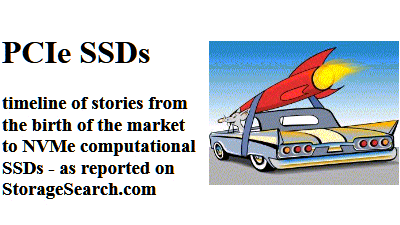How will the hard drive market fare...
in a solid state storage world?by Zsolt Kerekes,
editor - November 13, 2012 |
This article
looks at an evolving set of storage market adoption models which - in the
past - had to explain why SSDs would find a place in an HDD dominated world.
And it joins the dots from - where we have been - and are now -
to project ahead to a time when it's the hard drives which will struggle to
find viable market gaps in a storage world dominated by SSDs. |
|
How will the hard drive market fare...
in an SSD storage world?
I only write about SSD
related topics that I'm thinking about or am interested in.
So the
last thing I ever thought I'd be doing in the last quarter of 2012 is writing
yet another article about
hard drives -
especially in this slot - the home page of StorageSearch.com - which has been
reserved in recent years for thought leading SSD articles.
It's nearly
3 years since I last wrote anything substantial about HDDs - and the reason is
simple. My analysis had led me to the conclusion that whatever products or
technologies might come out of the hard drive market in future years - would
have no significant impact on slowing down or preventing the ultimate growth of
the solid state storage market. And I've only got one brain - which defies all
attempts at overclocking and parallelization. Struggling to understand and
make sense of the SSD market is complicated enough - so I could see no more
reason to waste time thinking about or writing about HDDs - except occasionally
to note when some particular event demonstrated another phase in the
technology's displacement.
the past of HDD vs SSD sophistry
Although
the idea of technically replacing HDDs by SSDs went back decades - 2005
was a bloom year for this type of article. Apart from some
rare exceptions -
most of the published "analysis" on this theme I had seen was
transfixed on the moving relative target of HDD versus flash memory price /
capacity curves - even though it was known to some business experts in
the SSD industry that other factors could be just as important.
I
didn't claim any originality for my
2003 article about
SSD-CPU equivalence - I merely used it to signal to readers that the total
available market for enterprise accelerator SSDs could about 100x
bigger than the actual revenue of the market at that time. In fact it was a
surprise to me that others hadn't done the same kind of calculations. And that
was a special case of SSDs replacing servers - and not - SSDs replacing hard
drives.
My own thoughts on the subject of
SSD adoption and HDD
displacement evolved as a dialog with readers over a period of many
years and articles.
- 2005 - why
buy SSDs? - 5 user value propositions - the 2nd generation SSD market
adoption model from StorageSearch.com - which analyzed and described the
different reasons for SSDs use - and which is still a good outline analysis
today.
A key conclusion of this analysis was that in most
applications for SSDs the price per gigabyte of SSD compared to HDD was
irrelevant to understanding SSD market adoption and was not the right
competitive comparison to make.
- 2007 - How
Solid is Hard Disk's Future? - suggested a capacity ratio based
formula for anticipating where SSDs would replace HDDs in consumer markets. (It
still stands the test of time today.)
The article also said that due
to the small size of the SSD market relative to the HDD market at that point
- it was likely that both markets could grow in revenue at the same time for
many years as this was "not a zero sum game" (even if the growth rate
of the SSD market was very high).
- 2010 - this way
to the petabyte SSD - looked ahead to a time (which I guessed to be
around 2016) when I anticipate that SSDs would significantly replace HDDs
in datacenters (in over 50% of new systems) in "the last bastions of
hard drives in the datacenter" - as bulk online storage.
My
analysis showed that even in this most cost sensitive application - the
changeover would occur (based on extrapolating known technology and market
trends) even if the cost of hard drives continued to drop rapidly - and even
if hard drive capacity was free!
That stunning conclusion - based on
SSD market
boundary analysis - was the clincher for me. And after the article was
published some SSD company CEOs told me it was a Eureka moment for them too.
You can argue about whether that 2016 date still looks appropriate
from today's perspective. There are arguments for saying it will come sooner in
some markets and later in others. But I didn't entirely stop thinking
about hard drives in an SSD world.
From time to time HDDs have
sometimes popped up in a supporting role in 3 other types of news story and
article.
- 2005 to 2012 - Hybrid
storage drives (modules / components) were seized on by hard drive makers as
an attractive tactic for carrying on business as usual and staving off
the threat of SSDs by treating flash as just another special type of buffer or
cache in a hard drive.
But this delusion meant that HDD makers
delayed far too long in recognizing and grabbing the real market
opportunities of SSDs.
While the hard drive makers wasted their talent
on designing expensive, complicated and undesirable rotating magnetic
disk/flash hybrids - the true SSD companies just got better at developing
native SSD technologies and markets which evolved out of the reach and ken
of HDD companies - except by way of
SSD company and IP
acquisitions and licensing.
- Customer case studies of the - shooting HDD fish in an SSD barrel
stories variety - by which I mean the kind of story put out by SSD
accelerator companies about how one of their customers replaced short stroked
hard drives with an SSD rack (or two).
This is a marketing
communications practice I grew so tired of that I bemoaned it in a 2008
article - Calling
for an End to Unrealistic SSD vs HDD IOPS Comparisons in which I bluntly
stated that the real competition for fast enterprise SSDs is other fast
SSDs.
When SSD vendors publish case studies about replacing old
rotating storage arrays - as indeed they sometimes still do - it doesn't
impress anyone. And it demonstrates that even SSD companies don't always
understand the mood of users in the SSD market.
- 2009 to 2012 - Auto
tiering / caching appliances (SSD ASAPs) come in
many shapes and
sizes.
In 2010 - I realized that these SSD ASAPs would always be
needed - even in a
pure SSD storage world.
From that time onwards - in my editorial,
talking to readers and in my thinking too - I consciously and sometimes
unconcsiously - segmented these companies into 2 types.
- those with an HDD weighted outlook - either because they leveraged a lot
of HDD specific IP, or because they had an HDD-oriented center of gravity in
their marketing and business development thinking.
In my SSD elitist
view I think of this category of SSD caching/tiering vendors as the
rotationally-fated / doomed to crash when the HDD market spins down. They will
find it hard to adjust to a zero RPM storage future.
- those with an SSD weighted outlook - whose architecture and marketing can
work just as well in the context of a pure solid state storage market as in
the short lived market operating alongside enterprise hard drives.
Although
they'll still find it tough competing to establish their place among the several
leading SSD software platforms of the future - they could become the entry
point through which millions of users view the rest of the SSD market. So
- when I say that in the last 2-3 years:- "I stopped thinking and writing
about hard drives" - what I mean is that compared to the many hundreds
of articles I was writing about SSDs - and content with my view that hard
drives posed no new or insurmountable challenges for the SSD market it was
rare that I gave them any thought.
But in the 2nd half of 2012 -
a strange thing happened.
I was getting more reader emails
asking me to clarify the phenomenon which they loosely called "HDD's
displacement by SSDs".
As you know - I would never call it
that - because I expect that in the long term the SSD market will be bigger in
revenue than the HDD market ever was.
SSDs do more than replace hard
drives and servers. - SSDs enable the creation of new data markets which could
never have worked in an HDD only world - because the new apps rely on
latency and data artchitecture processing assumptions which are on a
performance scale which is impossible or uneconomic to achieve with storage
which isn't solid state.
Anyway - when readers asked for my opinion
about the demise of HDDs I knew what they meant.
As I learned
more about where these readers were coming from I got less surprised at getting
these questions..
- investors in hard drive storage makers are wondering what impact all those
billions of SSD dollars might have on HDD purchases.
- readers who are new to the SSD market probably haven't seen my older
articles.
- even readers who had read my earlier SSD adoption articles felt
uncomfortable with making big leaps - across the chasms from where my old
HDD narratives had stopped - to the next place. Whatever that next place might
be.
here's the new stuff
So, without wishing to
repeat too much of what I've already written before here's a set of condensed
notes (extracted from recent emails) in which I have described how I see the
HDD-SSD thing working out in the next 2-3 years. As with any technical
clairvoyancy - I caution you that it could be wrong. But these are the best
guesses I have to offer - until better guesses or reality replace them.
will
HDD use migrate to SSD?
No.
It's not exactly like
that. In the long term the SSD market will be bigger in revenue than the HDD
market ever was.
Until recently most of the use of SSDs in enterprise servers have been
replacing server budgets rather than storage.
enterprise
We're at a turning point where SSDs are
starting to be used by early adopters in the enterprise as pure bulk storage
devices. But we're still 3-4 years away from that becoming mainstream. That's
because we are also in a market today where if an oem has a choice of how to
repurpose 10,000 flash chips in a box they can make much more money by packing
those flash chips into a fast SSD rather than a low power consumption bulk
storage SSD.
In the next 3 to 4 years - some vendors will move closer to the
fast-enough and cloud / bulk SSD silo because they cant do the fast stuff and
others will choose it deliberately. The technologies already exist to widen
and clarify these roles. But as long as enterprise SSD makers have the easy
ride up the tornado they will defer making difficult choices.
When
some SSD market leadership positions become entrenched - in the next few years
and when competition between SSD rack makers becomes a really much tougher
issue than it is now (when it's so easy to find new customers who don't already
have legacy SSD allegiences) - the vacant lot of - "doing economic HDD
replacement" - without also having to bundle in massive performance too
will appear more attractive as a product marketing option - for those seeking
new markets. That's the market model for the
bulk storage / 1U
petabyte SSD.
consumer
In the
notebook market
HDDs currently have a role in entertainment pcs where the device is holding a
significant amount of video, music etc and where performance (speed or battery
life) are not prime requirements.
The entertainment PC will fragment into users who have different
preferences and options re cloud vs having it in their hands storage.
Do users need to have hundreds or thousands of movies on their PCs?
or will most of them decide its OK to have 50, 100, 200.
I think the
convenience of streaming video and movie services means most consumers will be
satifisfied with a hybrid approach which is having enough local storage for
the legacy stuff theyve already got (and like to watch in the hut or listen to
in the car) while relying mostly on the cloud for the newer stuff. That
would lead to a glass ceiling for HDD capacity in PC like systems
- above which the capacity wasn't necessary. Which means the SSD can creep up
and take over.
As for the
cloud that will
eventually all be solid state because of cost of ownership.
The HDD
market isn't going to disappear in the next 5 years because hard disk makers
will find new markets. Its just that the most profitable markets they used to
have in the datacenter will fade away.
will HDD revenue decline
gradually or abruptly?
This depends how markets behave - and not
just the potential of the respective technologies.
As I predicted in my
2003 article about SSD-CPU
equivalence once a single major server oem adopted factory fitted SSD
acceleration all the others would follow very soon after or become
uncompetitive. That turned out to be FIO being adopted by HP, IBM, Dell etc
It was the switch from seeing SSDs as a threat to CPU sales and instead a
necessary and better product for server makers to sell.
When HDD sales collapse in the server market I anticipate it will be a
catastrophic fall on the order of 30% to 50% within a single year.
The precise placement of that year could be 2015/16 which is what
I've been saying in earlier articles published in 2009 and 2010.
A lot of servers are already going out the factory door with SSDs
fitted where previously there would have been SAS HDDs. When server vendors
have proved for a year or so that SSDs as singles or in arrays get a good
customer reaction and when the new value engineered
efficient architecture
enterprise SSDs have reached compelling price advantages compared to classic
enterprise SSDs and when a single array maker like
IBM discloses it has
shipped billions of dollars of RamSan SSD racks confidence in the SSD market
will increase.
Another factor is apps.
Before long all enterprises will rely on software elements which can
only work with SSDs. HDD arrays wont be able to run the new generation of
killer enterprise software because HDD IOPS are too slow. Its the combination
of these several factors which will lead to collapse of demand in enterprise
SSDs. Any one factor can be mitigated.
is cost per terabyte the best way to think about SSD cost?
No.
Capacity is only one
dimension of SSD cost - and not always the most important. In my 3rd
generation enterprise SSD market model (SSD silos) makes a good
applications and architecture based case for upto 4 distinct speeds of SSDs
having sustainably different applications roles within an all solid state
datacenter. (With another 3 specialist types of functionally different SSDs
inter-operating among them.)
The value propositions within these
distinct SSD silos varies - according to the role that these specialist SSDs
will have.
If you step back and look across the whole SSD
infrastructure investment in the enterprise - a useful top level cost metric
might $ per user who gets a satisfactory apps experience.
That's
going to be a different number in different markets and in different
applications.
At the extreme capacity end of the SSD market -
archive storage - for
example - getting the lowest power consumption and maximum capacity per rack
unit will be the main factors - and speed will almost be irrelevant. Whereas -
in the ultra-fast end of the apps acceleration architecture - the prime
determinants of price will be speed factors such as low latency and high IOPS
rather than capacity. And that's just the enterprise market.
The same
SSD capacity will have a different market price in military, industrial and
consumer markets too. Because the SSDs are very different products with
different market specific attributes (such as reliability, ruggedness, security)
and ease of integration into the required apps / use cases. And even within the
consumer gadget market - we could start to see different levels of acceptable
price / performance SSDs in different types of product.
This is a
completely different world view than for hard drives - which have been
fossilized into a small
RPM
based differentiated model for more than 10 years.
A better analogy for
SSDs is comparisons with processor pricing. But SSDs are more complex than CPUs
and have more dimensions of apps related functionality.
conclusion
There's a lot more to the SSD story than its role in displacing
hard drives in storage. SSDs enable new types of data processing architecture
and are one of the 3
most disruptive electronics based business enabling technologies in the
past 40 years. | | |
| . |
 |
| . |
It looks like you're seriously interested
in SSDs. So please take a look at my newest articles on the home page of
StorageSearch.com
|
| . |
 |
| |
.... |
|













